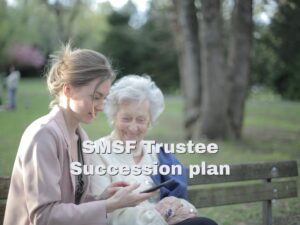Creating a robust SMSF trustee succession plan is critical for Self-Managed Super Funds (SMSFs) managed by aging trustees.
An effective succession plan ensures the smooth transition of control and management of the SMSF when the original trustees are no longer able or willing to manage the fund due to age, health, or other reasons. A trustee succession plan must encompass preparation, clear communication, and legal compliance.
Understanding SMSF Trustee Succession
SMSF trustee succession plan involves preparing for the future management of the SMSF, ensuring it continues to operate effectively and complies with Superannuation Industry (Supervision) Act 1993 (SIS Act) requirements. Remember to check that your new Trustee appointment is suitable and not a disqualified person to act as an SMSF Trustee.
Looking after you and your SMSF. It’s about safeguarding the fund’s assets and the beneficiaries’ interests, ensuring that the transition of trusteeship does not negatively impact the fund’s performance or compliance status.
Early Planning
Start planning early. It can sometimes be a difficult decision or discussion, but dealing with dignity can mean no surprises. Don’t wait for health issues or other urgent matters to force a quick decision. Early planning allows for a thoughtful, strategic approach to selecting and preparing the next generation of trustees.
It also may mean reviewing the asset composition of the fund. This may result in uncomplicating the Funds strategy or selling down investments that require the Trustee’s time and experience to manage. Consult a Financial Planner if you require assistance in this area.
Selecting Successor Trustees for your SMSF
Consider potential successors’ capabilities, willingness to take on the responsibility, and their alignment with the fund’s goals. Successors can be family members, friends, or professional trustees. Discussing the responsibilities and expectations with potential successors is crucial to ensure they are prepared and willing to take on the role.
Ensure that the succession plan complies with the SIS Act and Trust Deed.
Check your Fund’s Trust Deed. You may need to update it to include provisions for the succession process. Consult with legal professionals to ensure the plan is legally sound and not inadvertently compromise the fund’s compliance status.
Documentation and Communication of your Trustee strategy
Document the succession plan clearly, including the roles, responsibilities, and process for transitioning trustees. Communicate the plan to all relevant parties, including current trustees, successors, and professional advisors such as your Accountant.
Keep your potential Trustees in the loop. This may either be by making them Trustees early or by keeping them informed annually with the audited financial statements.
Can my SMSF Trustee replacement get paid while carrying out their Trustee duties and my wishes?
As a trustee of an SMSF, your primary responsibility is to manage the fund prudently. Therefore you cannot receive compensation from the SMSF for fulfilling your trustee obligations, such as overseeing investments, administration, and compliance.
Review and update the succession plan regularly to reflect changes in the fund’s circumstances, membership, or legislation. This ensures the plan remains relevant and effectively safeguards the SMSF’s future.
A well-crafted trustee succession plan is essential for an SMSF’s long-term success and stability, particularly when managed by aging trustees. By taking a proactive approach to succession planning, SMSF trustees can ensure a seamless transition that protects the fund’s assets and the financial security of its members.
Ultimately, the goal is to ensure the SMSF continues to meet its members’ retirement goals, regardless of changes in its management. When it comes to Estate planning, peace of mind is thinking outside the unexpected and dealing with sometimes hard and awkward what-if scenarios.











